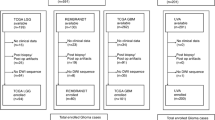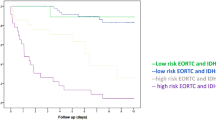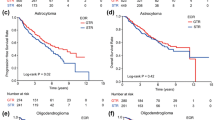Abstract
Objectives
To determine whether imaging-based risk stratification enables prognostication in diffuse glioma, NOS (not otherwise specified).
Methods
Data from 220 patients classified as diffuse glioma, NOS, between January 2011 and December 2020 were retrospectively included. Two neuroradiologists analyzed pre-surgical CT and MRI to assign gliomas to the three imaging-based risk types considering well-known imaging phenotypes (e.g., T2/FLAIR mismatch). According to the 2021 World Health Organization classification, the three risk types included (1) low-risk, expecting oligodendroglioma, isocitrate dehydrogenase (IDH)-mutant, and 1p/19q-codeleted; (2) intermediate-risk, expecting astrocytoma, IDH-mutant; and (3) high-risk, expecting glioblastoma, IDH-wildtype. Progression-free survival (PFS) and overall survival (OS) were estimated for each risk type. Time-dependent receiver operating characteristic analysis using 10-fold cross-validation with 100-fold bootstrapping was used to compare the performance of an imaging-based survival model with that of a historical molecular-based survival model published in 2015, created using The Cancer Genome Archive data.
Results
Prognostication according to the three imaging-based risk types was achieved for both PFS and OS (log-rank test, p < 0.001). The imaging-based survival model showed high prognostic value, with areas under the curves (AUCs) of 0.772 and 0.650 for 1-year PFS and OS, respectively, similar to the historical molecular-based survival model (AUC = 0.74 for PFS and 0.87 for OS). The imaging-based survival model achieved high long-term performance in both 3-year PFS (AUC = 0.806) and 5-year OS (AUC = 0.812).
Conclusion
Imaging-based risk stratification achieved histomolecular-level prognostication in diffuse glioma, NOS, and could aid in guiding patient referral for insufficient or unsuccessful molecular diagnosis.
Key Points
• Three imaging-based risk types enable distinct prognostication in diffuse glioma, NOS (not otherwise specified).
• The imaging-based survival model achieved similar prognostic performance as a historical molecular-based survival model.
• For long-term prognostication of 3 and 5 years, the imaging-based survival model showed high performance.




Similar content being viewed by others
Abbreviations
- AUC:
-
Area under the curve
- CI:
-
Confidence intervals
- FLAIR:
-
Fluid-attenuated inversion recovery
- HR:
-
Hazard ratio
- IDH:
-
Isocitrate dehydrogenase
- NOS:
-
Not Otherwise Specified
- OS:
-
Overall survival
- PFS:
-
Progression-free survival
- RANO:
-
Response Assessment in Neuro-Oncology
- ROC:
-
Receiver operating characteristic
- WHO:
-
World Health Organization
References
Hu N, Richards R, Jensen R (2016) Role of chromosomal 1p/19q co-deletion on the prognosis of oligodendrogliomas: a systematic review and meta-analysis. Interdisciplinary Neurosurgery 5:58–63
Jenkins RB, Blair H, Ballman KV et al (2006) A t(1;19)(q10;p10) mediates the combined deletions of 1p and 19q and predicts a better prognosis of patients with oligodendroglioma. Cancer Res 66:9852–9861
Brat DJ, Verhaak RG, Aldape KD et al (2015) Comprehensive, integrative genomic analysis of diffuse lower-grade gliomas. N Engl J Med 372:2481–2498
Louis DN, Perry A, Reifenberger G et al (2016) The 2016 World Health Organization Classification of Tumors of the Central Nervous System: a summary. Acta Neuropathol 131:803–820
Louis DN, Wesseling P, Paulus W et al (2018) cIMPACT-NOW update 1: Not Otherwise Specified (NOS) and Not Elsewhere Classified (NEC). Acta Neuropathol 135:481–484
Smits M, van den Bent MJ (2017) Imaging correlates of adult glioma genotypes. Radiology 284:316–331
Maynard J, Okuchi S, Wastling S et al (2020) World Health Organization Grade II/III Glioma Molecular Status: Prediction by MRI Morphologic Features and Apparent Diffusion Coefficient. Radiology 296:111–121
Patel SH, Batchala PP, Mrachek EKS et al (2020) MRI and CT identify isocitrate dehydrogenase (IDH)-mutant lower-grade gliomas misclassified to 1p/19q codeletion status with fluorescence in situ hybridization. Radiology 294:160–167
Weller M, van den Bent M, Preusser M et al (2021) EANO guidelines on the diagnosis and treatment of diffuse gliomas of adulthood. Nat Rev Clin Oncol 18:170–186
Broen MPG, Smits M, Wijnenga MMJ et al (2018) The T2-FLAIR mismatch sign as an imaging marker for non-enhancing IDH-mutant, 1p/19q-intact lower-grade glioma: a validation study. Neuro Oncol 20:1393–1399
Patel SH, Poisson LM, Brat DJ et al (2017) T2-FLAIR Mismatch, an imaging biomarker for IDH and 1p/19q status in lower-grade gliomas: a TCGA/TCIA Project. Clin Cancer Res 23:6078–6085
Arevalo O, Valenzuela R, Esquenazi Y et al (2017) The 2016 World Health Organization Classification of Tumors of the Central Nervous System: a practical approach for gliomas, part 2. Isocitrate dehydrogenase status—imaging correlation. Neurographics 7:344–349
Louis DN, Perry A, Wesseling P et al (2021) The 2021 WHO Classification of Tumors of the Central Nervous System: a summary. Neuro Oncol 23:1231–1251
Wen PY, Macdonald DR, Reardon DA et al (2010) Updated response assessment criteria for high-grade gliomas: response assessment in neuro-oncology working group. J Clin Oncol 28:1963–1972
Leao DJ, Craig PG, Godoy LF, Leite CC, Policeni B (2020) Response assessment in neuro-oncology criteria for gliomas: practical approach using conventional and advanced techniques. AJNR Am J Neuroradiol 41:10–20
Rudie JD, Rauschecker AM, Bryan RN, Davatzikos C, Mohan S (2019) Emerging applications of artificial intelligence in neuro-oncology. Radiology 290:607–618
Katki HA (2019) Quantifying risk stratification provided by diagnostic tests and risk predictions: comparison to AUC and decision curve analysis. Stat Med 38:2943–2955
Pope WB, Sayre J, Perlina A, Villablanca JP, Mischel PS, Cloughesy TF (2005) MR imaging correlates of survival in patients with high-grade gliomas. AJNR Am J Neuroradiol 26:2466–2474
Feraco P, Bacci A, Ferrazza P et al (2020) Magnetic resonance imaging derived biomarkers of IDH mutation status and overall survival in grade III astrocytomas. Diagnostics (Basel) 10
Park YW, Han K, Ahn SS et al (2018) Prediction of IDH1-mutation and 1p/19q-codeletion status using preoperative MR Imaging Phenotypes in lower grade gliomas. AJNR Am J Neuroradiol 39:37–42
Zhou H, Vallières M, Bai HX et al (2017) MRI features predict survival and molecular markers in diffuse lower-grade gliomas. Neuro Oncol 19:862–870
Zinn PO, Colen RR (2013) Imaging genomic mapping in glioblastoma. Neurosurgery 60(Suppl 1):126–130
Patel AP, Tirosh I, Trombetta JJ et al (2014) Single-cell RNA-seq highlights intratumoral heterogeneity in primary glioblastoma. Science 344:1396–1401
Parker NR, Khong P, Parkinson JF, Howell VM, Wheeler HR (2015) Molecular heterogeneity in glioblastoma: potential clinical implications. Front Oncol 5:55
Qi S, Yu L, Li H et al (2014) Isocitrate dehydrogenase mutation is associated with tumor location and magnetic resonance imaging characteristics in astrocytic neoplasms. Oncol Lett 7:1895–1902
Metellus P, Coulibaly B, Colin C et al (2010) Absence of IDH mutation identifies a novel radiologic and molecular subtype of WHO grade II gliomas with dismal prognosis. Acta Neuropathol 120:719–729
Carrillo JA, Lai A, Nghiemphu PL et al (2012) Relationship between tumor enhancement, edema, IDH1 mutational status, MGMT promoter methylation, and survival in glioblastoma. AJNR Am J Neuroradiol 33:1349–1355
Krieg SM, Schnurbus L, Shiban E et al (2013) Surgery of highly eloquent gliomas primarily assessed as non-resectable: risks and benefits in a cohort study. BMC Cancer 13:51
Darvishi P, Batchala PP, Patrie JT et al (2020) Prognostic value of preoperative mri metrics for diffuse lower-grade glioma molecular subtypes. AJNR Am J Neuroradiol 41:815–821
Batchala PP, Muttikkal TJE, Donahue JH et al (2019) Neuroimaging-based classification algorithm for predicting 1p/19q-codeletion status in IDH-mutant lower grade gliomas. AJNR Am J Neuroradiol 40:426–432
Nam YK, Park JE, Park SY et al (2021) Reproducible imaging-based prediction of molecular subtype and risk stratification of gliomas across different experience levels using a structured reporting system. Eur Radiol 31:7374–7385
White ML, Zhang Y, Kirby P, Ryken TC (2005) Can tumor contrast enhancement be used as a criterion for differentiating tumor grades of oligodendrogliomas? AJNR Am J Neuroradiol 26:784–790
Yamashita K, Hiwatashi A, Togao O et al (2016) MR imaging-based analysis of glioblastoma multiforme: estimation of IDH1 mutation status. AJNR Am J Neuroradiol 37:58–65
Funding
This research was supported by a National Research Foundation of Korea (NRF) grant funded by the Korean government (MSIP) (grant number: NRF-2020R1A2B5B01001707) and by the Ministry of Health and Welfare, South Korea (HI21C1161).
Author information
Authors and Affiliations
Corresponding author
Ethics declarations
Guarantor
The scientific guarantor of this publication is Ji Eun Park.
Conflict of interest
The authors declare no competing interests.
Statistics and biometry
One of the authors has significant statistical expertise (Seo Young Park, 10-year experienced statistician).
Informed consent
Written informed consent was waived by the Institutional Review Board.
Ethical approval
Institutional Review Board approval was obtained.
Methodology
• retrospective
• diagnostic or prognostic study
• performed at one institution
Additional information
Publisher’s note
Springer Nature remains neutral with regard to jurisdictional claims in published maps and institutional affiliations.
Supplementary Information
ESM 1
(DOCX 25 kb)
Rights and permissions
About this article
Cite this article
Jang, E.B., Kim, H.S., Park, J.E. et al. Diffuse glioma, not otherwise specified: imaging-based risk stratification achieves histomolecular-level prognostication. Eur Radiol 32, 7780–7788 (2022). https://doi.org/10.1007/s00330-022-08850-z
Received:
Revised:
Accepted:
Published:
Issue Date:
DOI: https://doi.org/10.1007/s00330-022-08850-z




